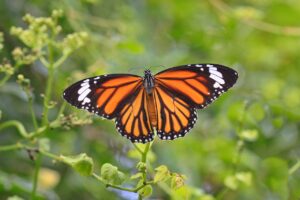The Beautiful Monarch: Monarch Butterflies’ Amazing Journey
Millions of The Beautiful Monarch begin on one of the most stunning seasonal migrations in the lives of creatures every year. These tiny bugs, that weigh under a gram, travel more than 3,000 kilometers from their North American breeding areas to the central Mexican mountains in which they spent the winter. This incredible voyage demonstrates their resiliency as well as the intricate behaviors and environmental cues which guide them.

The Adventure Starts
The migration of the The Beautiful Monarch requires several generations to finish. The great-great-grandchildren of the people who set out for the journey tend to be the butterflies that depart North America in the fall. Compared to their short predecessors, these butterflies, nicknamed the “super generation,” may survive up to eight months. They navigate using a combination of the sun’s position, the earth’s magnetic fields, and an internal circadian clock that helps them maintain their course southward. The Beautiful Monarch fly migration is guided by a normal genetic program and the environment. They navigate using the sun’s position, the earth’s magnetic field, and topographical signals.
Pit Stops Along the Way
Milkweed plants belong to monarch butterflies’ survival. The one thing the females lay their eggs on is milkweed as a that the larvae consume as the sole food source. Because of this trust, keeping the habitats of milkweed is needed. Monarchs stop pauses on their route to eat nectar from various flowers, to fuel their long flight.
Mexico as a winter place
Thousands of Monarchs form a cluster and cover the tree trunks and branches in a vibrant orange blanket when they arrive in the oyamel fir forests of central Mexico. . It is ready to weather the winter and conserve heat because of their cluster. They often choose the same locations as their loved ones, have been going to for generations, it is an impressive reveal of instinct and memory.
The Journey Home
As temperatures rise in the spring, The Beautiful Monarch begin their journey northward. This return trip involves multiple generations, as the butterflies reproduce along the way. It can take up to four generations to complete the full round trip, with each generation continuing the legacy of migration.
Concerns to Conservation
The heavy use of pesticides, habitat loss, and climate change have also caused to a decrease in monarch amounts. Mexico’s forests and milkweed habitats are the main focus of conservation efforts. Individuals can help protect the survival of these wonderful pests for planting native milkweed with the use less the use of pesticide The Monarch butterfly’s migration is a testament to the wonders of nature and the resilience of even the smallest creatures. Their journey inspires awe and underscores the importance of preserving the natural world for future generations.
More than just beautiful insects, The Beautiful Monarch are the symbols of God’s creation and health signals for the environment. Their intricate life cycle, incredible migration, and challenges convey way ecosystems have links and how our behavior affects wildlife. For monarch butterflies to stay alive and the environmental legacy they represent to be preserved, conservation activities are essential. Knowing about and protecting these amazing animals also helps keep our planet’s biodiversity and ecological balance . More than just beautiful insects.
The Beautiful Monarch are the symbols of God’s creation and health signals for the environment. Their intricate life cycle, incredible migration, and challenges convey way ecosystems have links and how our behavior affects wildlife. For The Beautiful Monarch to stay alive and the environmental legacy they represent to be preserved, conservation activities are essential. Knowing about and protecting these amazing animals also helps keep our planet’s biodiversity and ecological balance.
